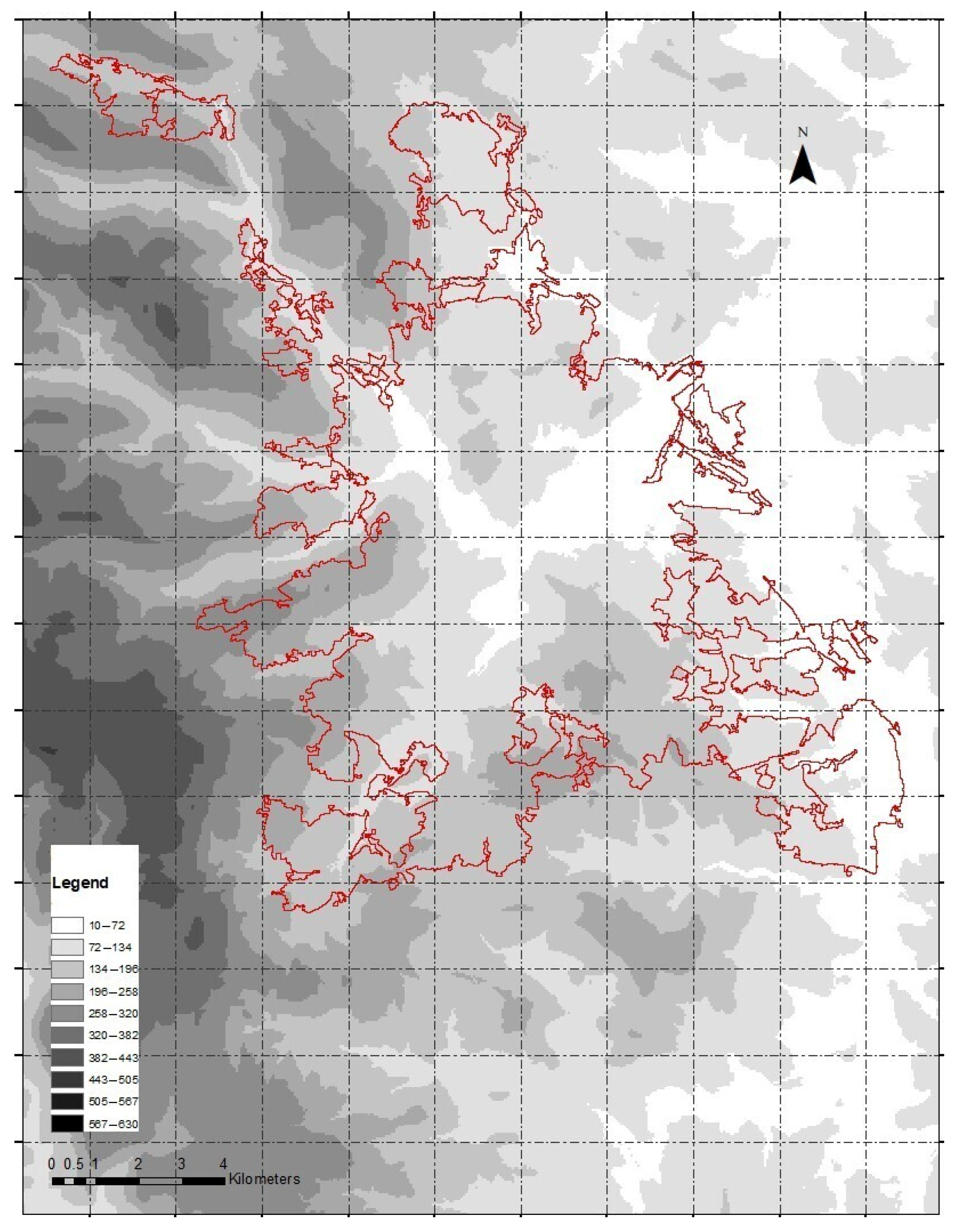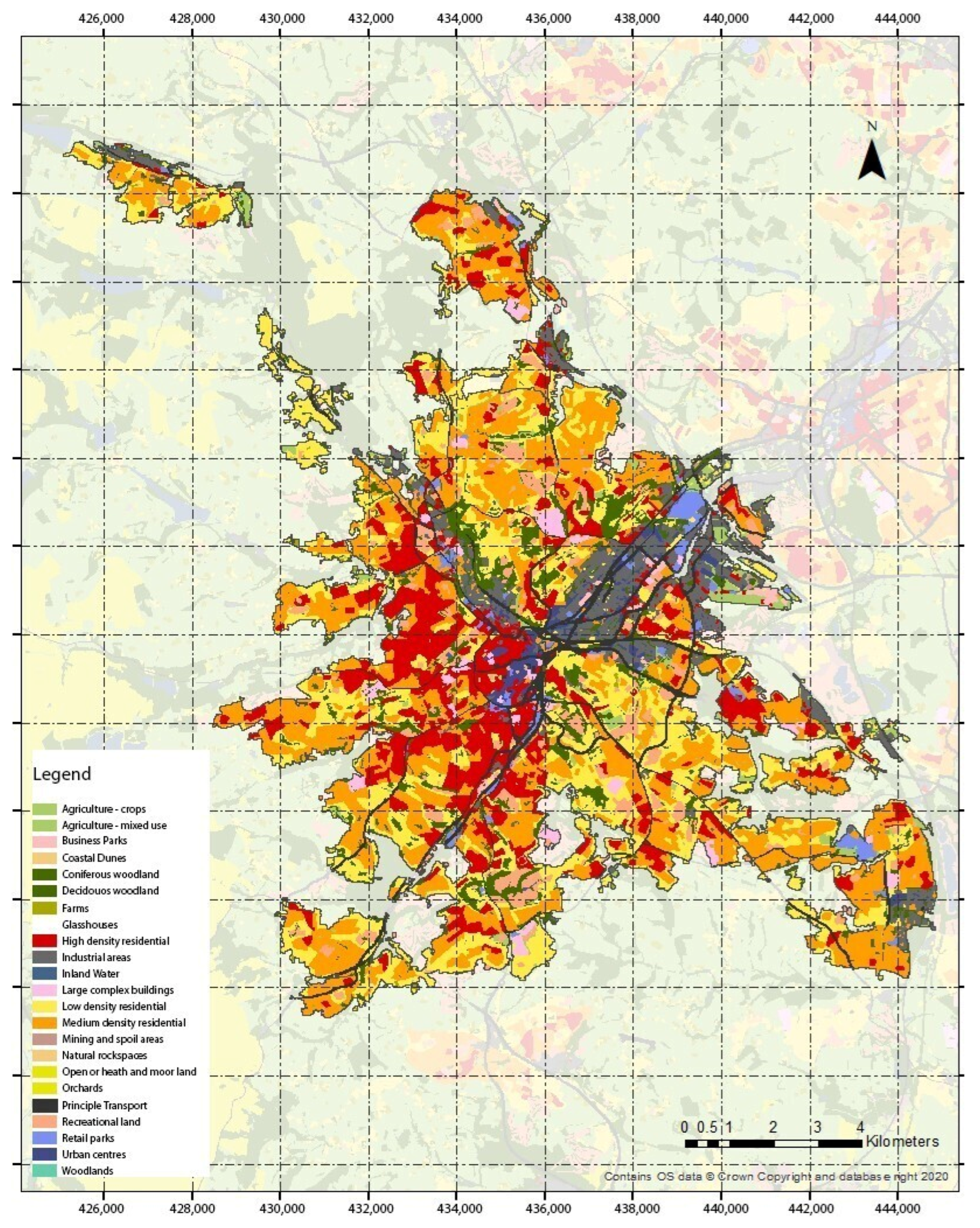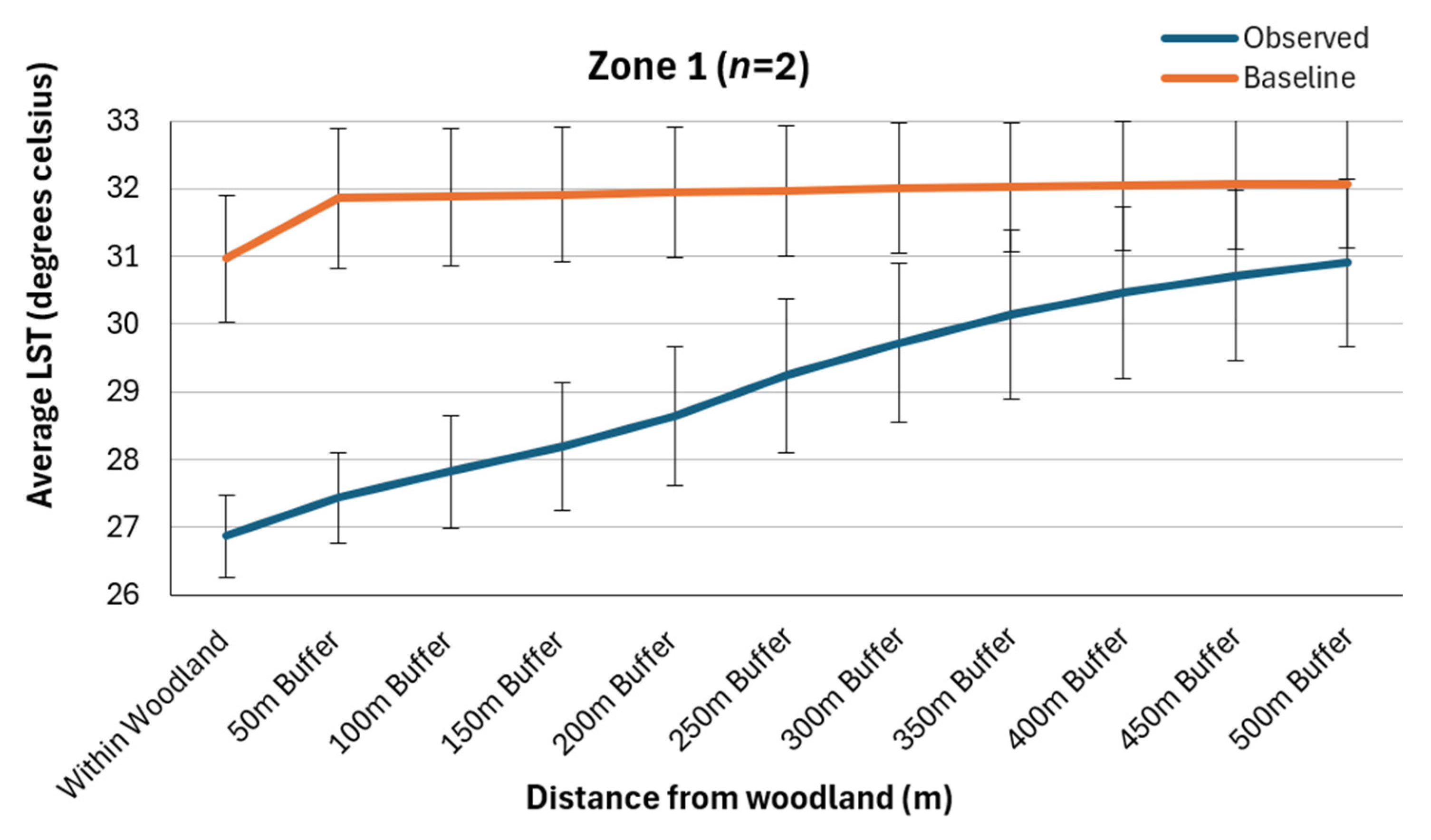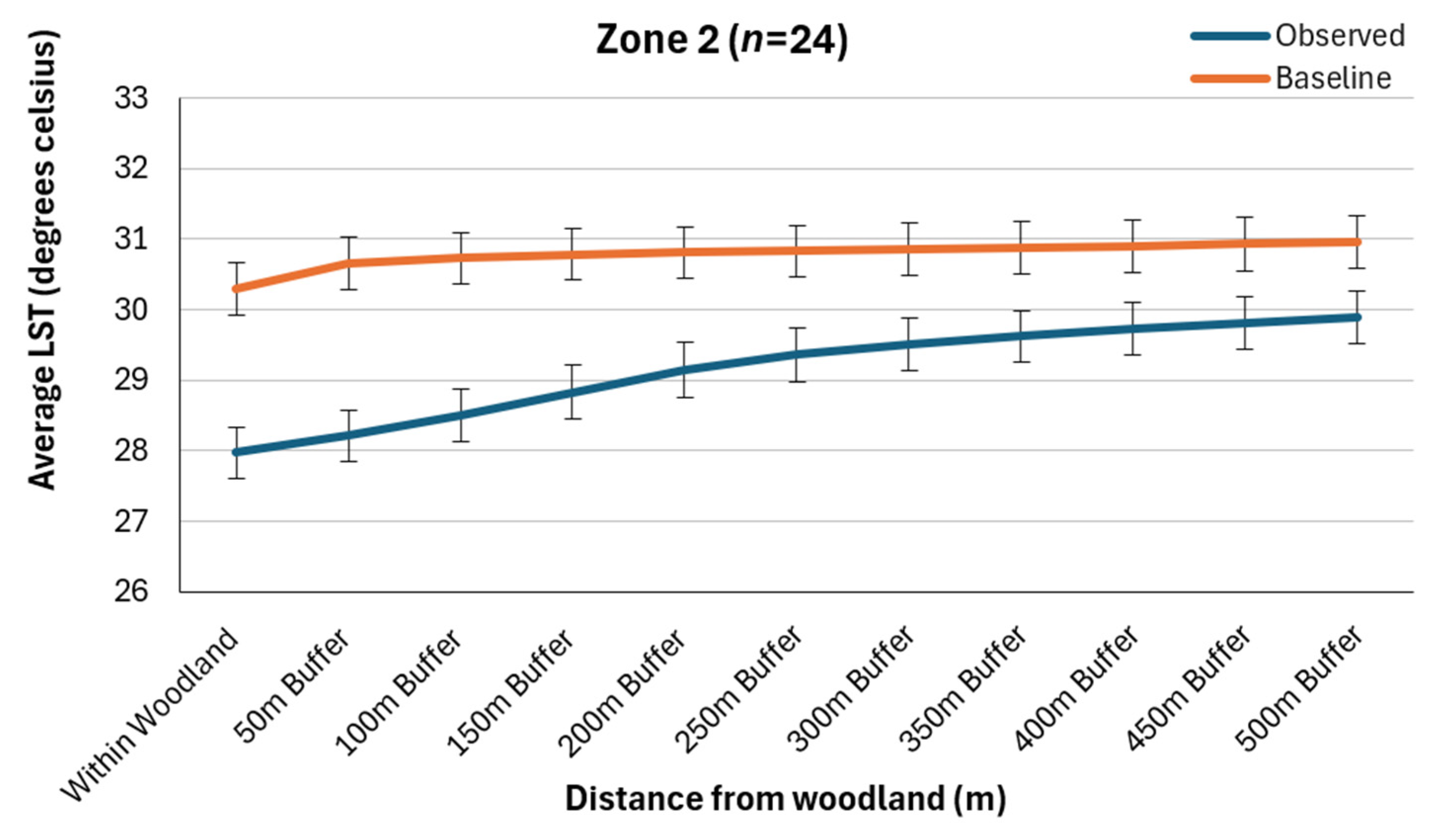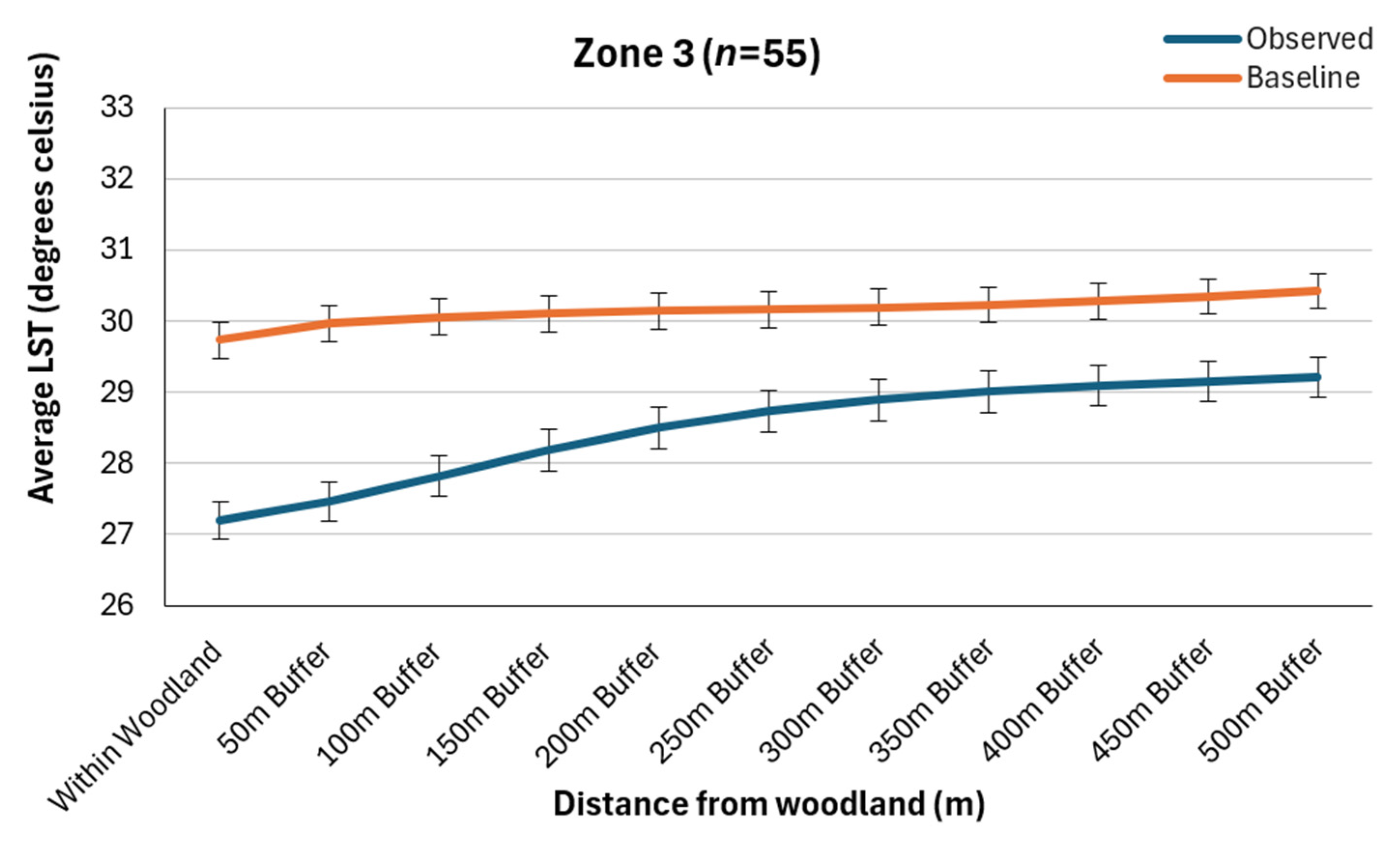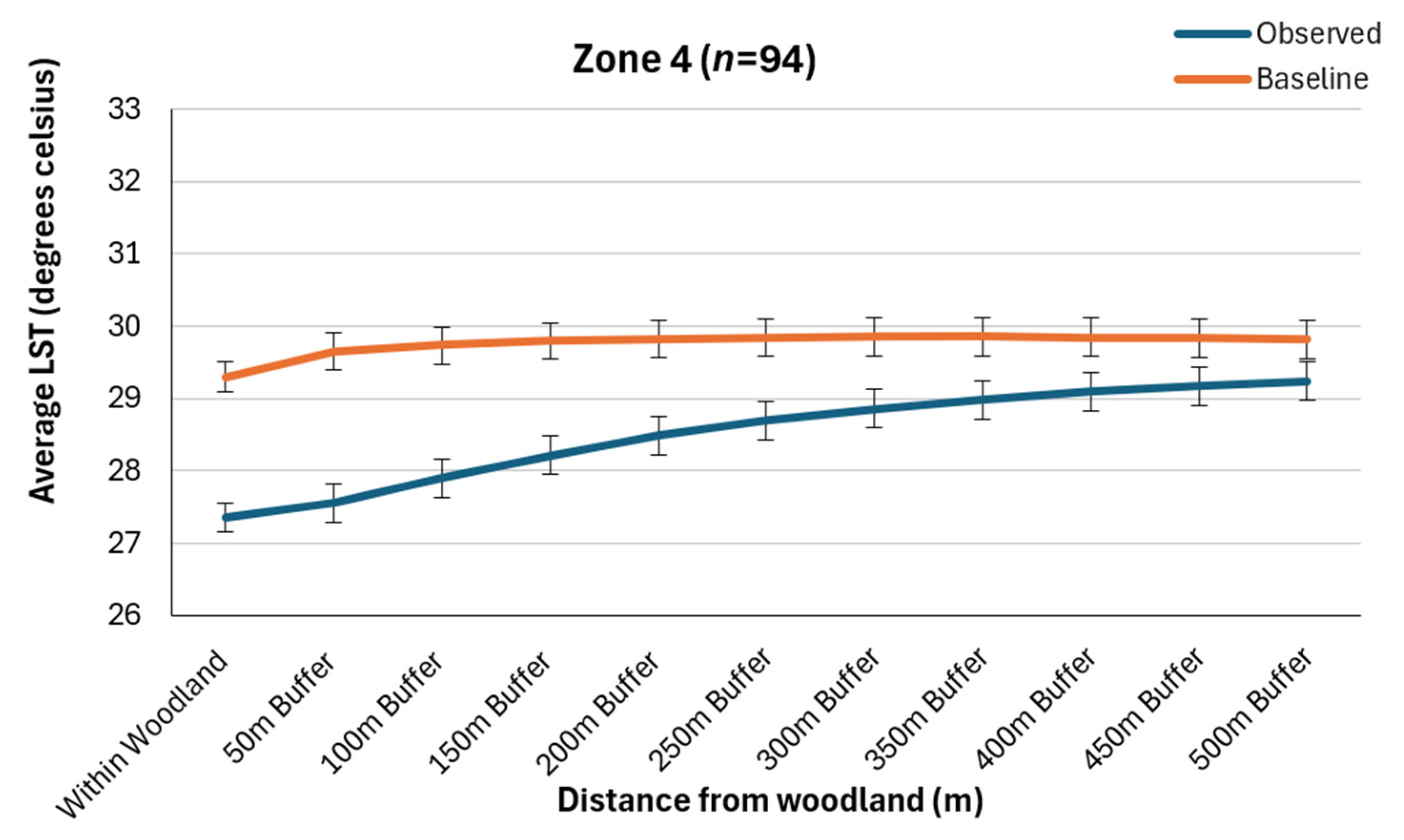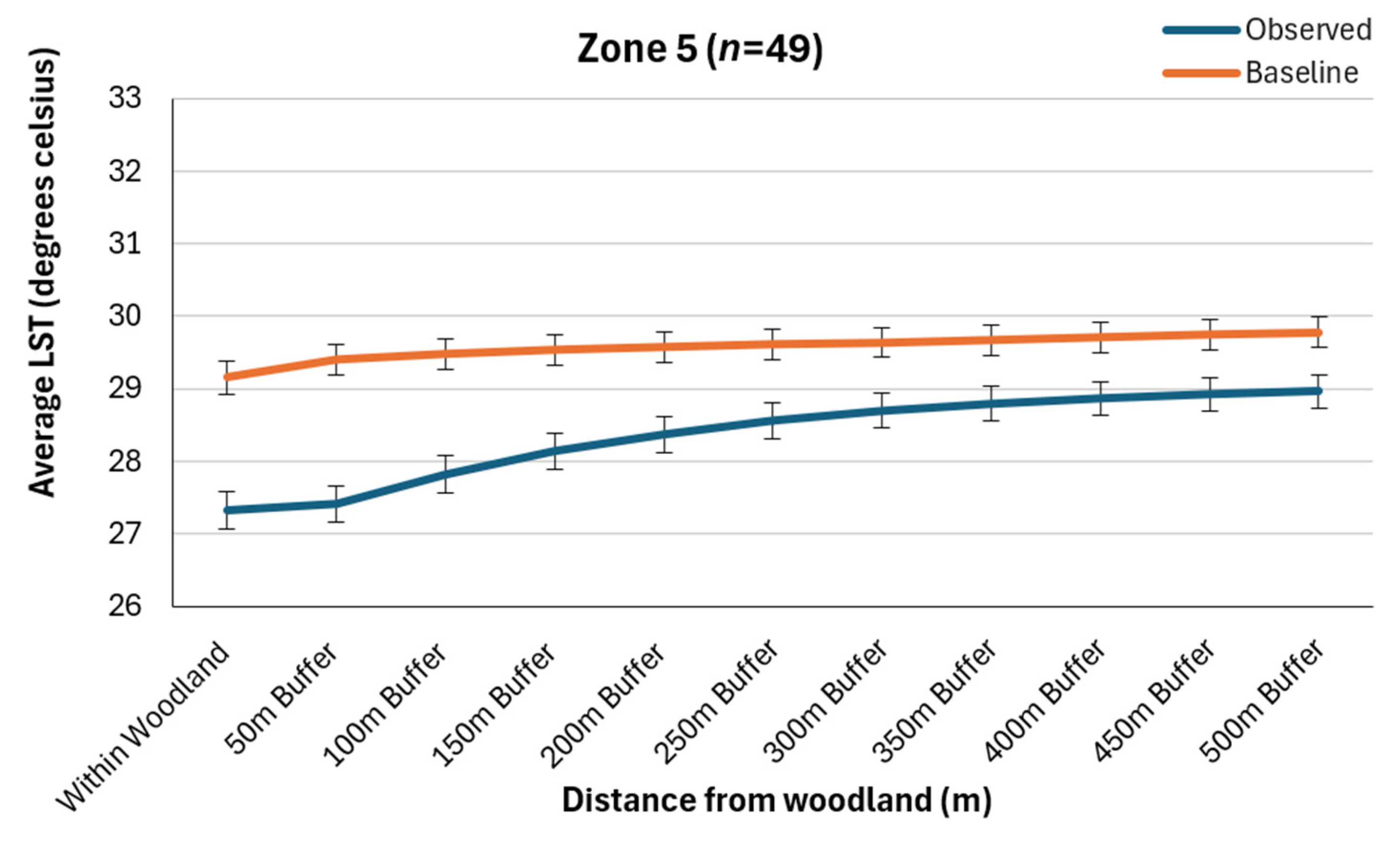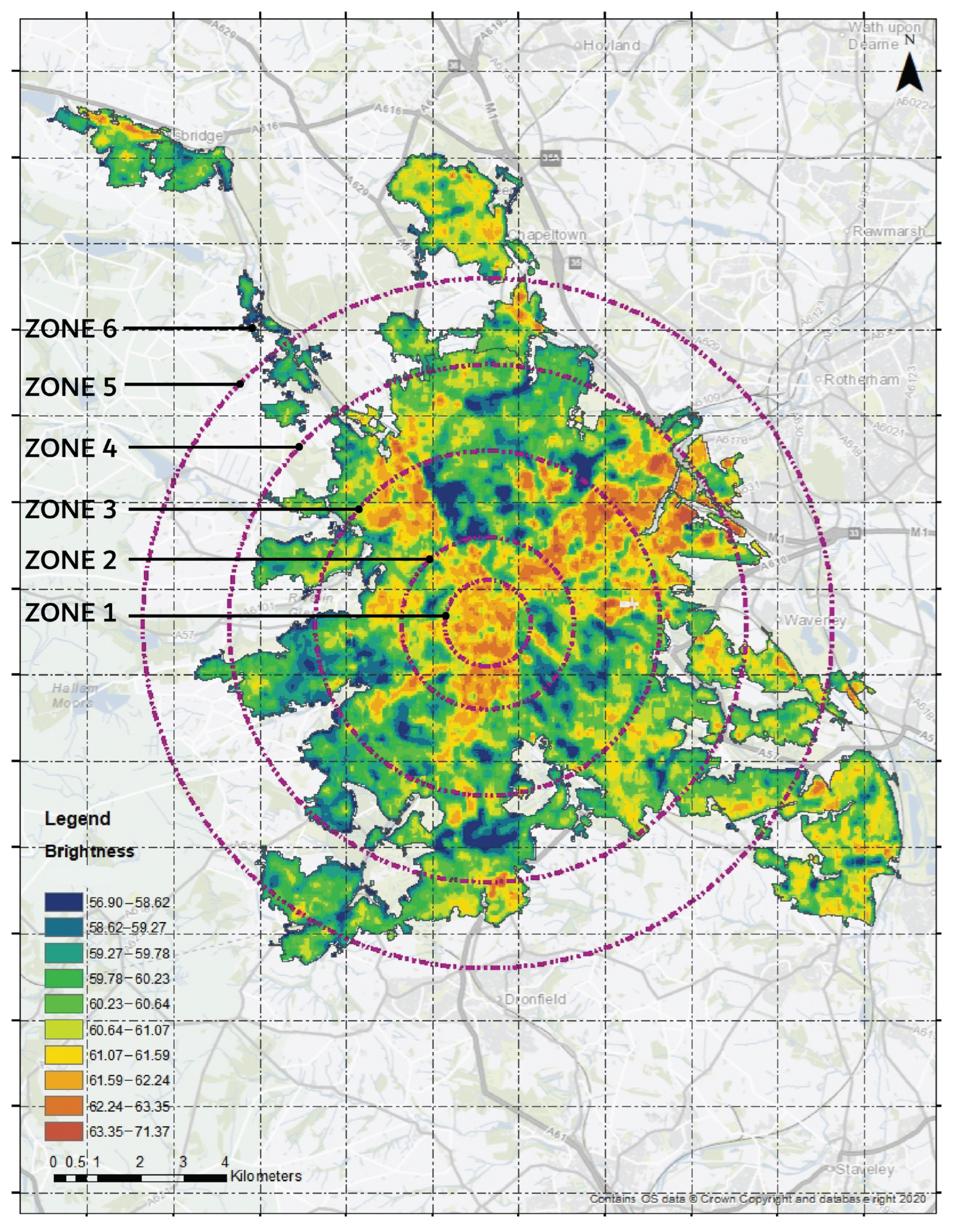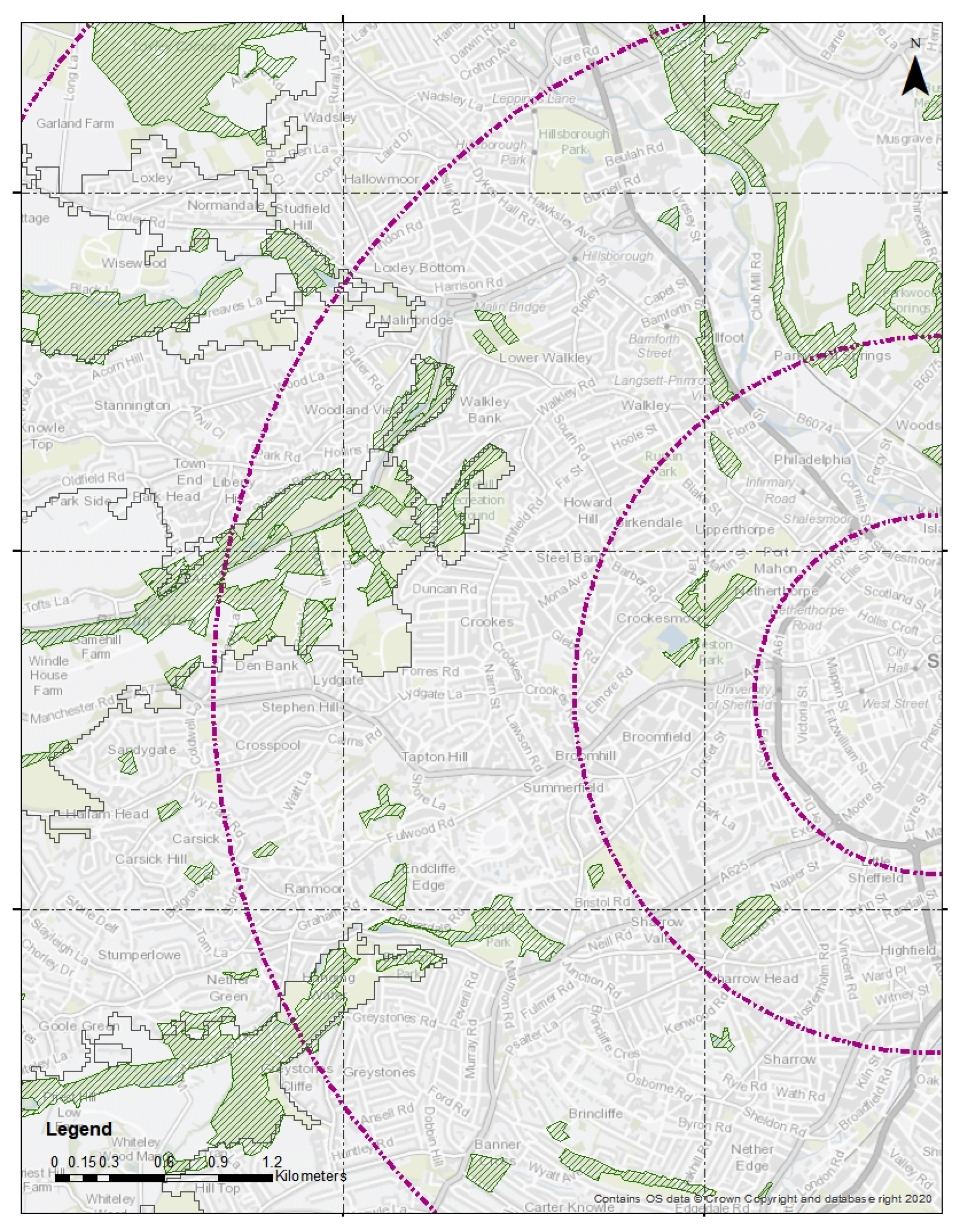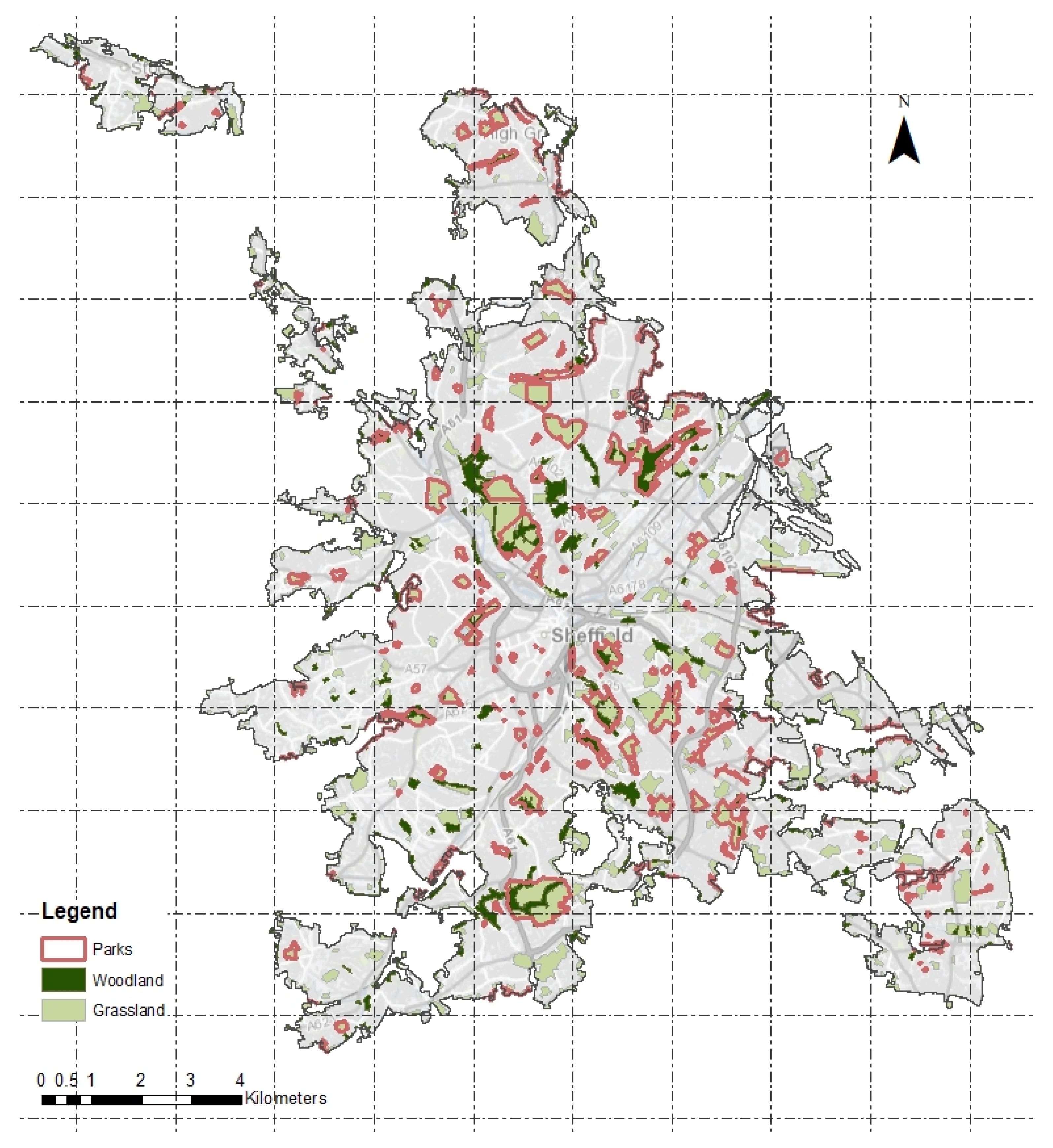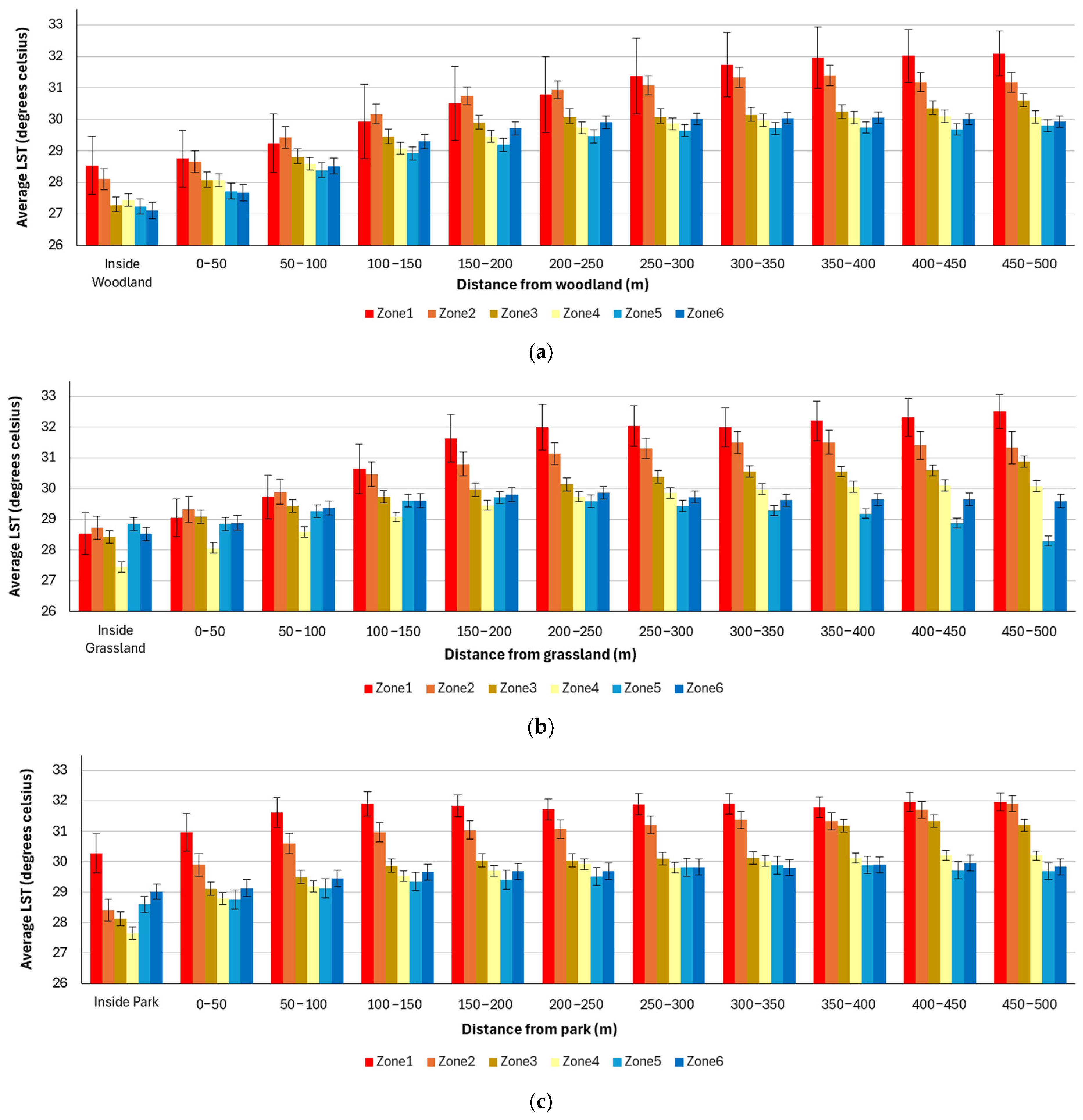1. Introduction
In recent decades, largely due to global climate change and the urban heat island (UHI) effect, many cities have experienced urban warming [
1]. This rise in urban heat has intensified the frequency and severity of heat events, heightening the risks for populations particularly vulnerable to extreme temperatures [
2]. There is a growing awareness of the importance of leveraging natural systems for climate resilience, advocating for Nature-Based Solutions (NBSs) that utilise green spaces to lower local temperatures and lessen overall thermal stress in cities. Urban green infrastructure includes a variety of green spaces such as street trees, parks, rain gardens, private yards, and green roofs. As a strategically planned network of natural and semi-natural areas [
3], green infrastructure has gained recognition as a crucial NBS for mitigating and adapting to urban heat [
4,
5]. A study in Glasgow (maritime temperate climate in Köppen–Geiger classification [
6]) stated that raising greenspace coverage by 20% beyond current levels could reduce the city’s projected 2050 UHI effect by approximately one-third to one-half [
7].
The cooling benefits of urban green spaces stem from mechanisms like plant evapotranspiration, shading, and increased albedo [
8], which have been clarified by numerous reviews [
8,
9]. Urban green spaces typically exhibit lower air temperatures during summer compared to the surrounding built-up areas, with mean temperatures 1 to 2 °C lower [
10], commonly called the “cool island effect”. Furthermore, due to the outward flow of cooler air during nighttime and early morning hours, which is known as “Park Breeze” [
11], the cooling influence of green spaces often extends into surrounding urban areas. Park breeze is characterised by a divergent outflow from the green space, and its speed is less than 1 m/s [
12]. It is believed that this breeze is driven by a thermally induced pressure gradient across the green space, functioning similarly to a gravity current [
13,
14]. The cooling effects within and beyond green space boundaries are especially evident under specific conditions: when the green space lies upwind, is positioned at a higher elevation relative to nearby urban areas, or is bordered by less-developed buffer zones. To improve the thermal conditions of the city and enhance residents’ thermal comfort, maximising the cooling effect of green spaces in surrounding urban areas has become an important research focus.
Currently, many quantitative studies have investigated the impact of green spaces on the surrounding urban thermal environment, and have summarised that the extent and intensity of this cooling effect are influenced by the local climate, the morphological characteristics of the green space, and the features of the surrounding urban environment [
8,
10]. In cities in temperate climate zones, regarding air temperature reduction, a study monitored the cooling effects of eight green spaces in London, found that, on average, small green spaces (ranging from 0.8 to 3.8 ha) cooled the surrounding area by 0.4 to 0.8 °C of nocturnal air temperature over a distance of approximately 30–120 m beyond their boundaries. Medium-sized green spaces (ranging from 10.1 to 12.1 ha) cooled the surrounding area by 0.6 to 1.0 °C over approximately 180–330 m [
15]. According to another field measurement in London, the nocturnal cooling influence of green spaces could reach as far as 440 m beyond their boundaries, with an average extent of 125 m. The cooling effect was observed to decline with distance, decreasing at an average rate of 1.4% per metre [
16]. Regarding land surface temperature (LST) reduction, a study in Copenhagen found that, during summer, 95% of blue-green spaces exhibit a cooling effect within a range of 60 to 210 m, with an average cooling extent of 150 m and an intensity of 2.47 °C. In spring, autumn, and winter, the mean cooling extent and intensity are 105 m and 1.53 °C; 120 m and 1.36 °C; and 90 m and 0.26 °C, respectively [
17].
Although a large number of studies on the cooling effects beyond green spaces already exist, their research focus are often broadly referred to as “urban green spaces.” According to De Haas, Hassink and Stuiver (2021), urban green space is defined as urban land, partly or completely covered with grass, trees, shrubs, or other vegetation [
18]. Due to differences in the types of vegetation cover (land cover), green spaces’ impact on the surrounding thermal environment may vary. There is currently no unified definition for the classification of green spaces. Parks are the predominant type of urban green space discussed in the literature relating to use and preference [
19]. The cooling effect of parks has been confirmed by numerous studies [
8]: for air temperature, a meta-analysis based on 89 studies showed that parks can reduce air temperature by 1.5–3.5 °C. As for LST, due to the better thermal conductivity of solid surfaces compared with air, parks have an even greater cooling potential [
20]. Remote sensing studies have observed reductions in LST ranging from 1.9 to 6.7 °C over 60–120 m spatial footprints [
8]. However, one problem with analysing parks as the units of analysis is that their land cover (and therefore heat reduction capacity) can be highly varied—including areas of trees, lawn, rocks, soil, water, build environments and so forth [
21]. In contrast, many studies classify green spaces through their land cover as either tree-dominated, shrub-dominated, or grass-dominated identified using visual interpretation or machine learning methods [
17,
22]. For instance, Yang et al. defined tree-covered and grass-covered green spaces as areas covered by more than 80% trees/grassland [
17]. By comparing LST across four seasons, they found that no matter which season, tree-covered green spaces are better than grass-covered green spaces in summer cooling or in winter warming. In summer, the cooling extent and intensity of tree-covered green spaces could meet 145 m, 3.58 °C, but grass covered were 105 m, 2.21 °C [
17]. Jonsson [
23] and Wong et al. [
24] also found similar conclusions, namely that the cool island effect of different types of green space differs obviously, trees provide the highest, while the shrubs and the grass provide the lowest.
In addition, the characteristics of the green space also have a significant impact on its cooling effect. Regarding green space’s morphology characteristics, many researchers choose to use certain patch-level metrics to describe their configuration. For example, the size (area) of patches has been found to provide a significant positive correlation with green space cooling effect in all climate zones [
10]. Based on a systematic review [
25], the Shape index (SHAPE) is one of the most frequently used 2D metrics. It is often analysed with LST-related indicators, such as cooling intensity, cooling distance, and cooling gradient, typically through bivariate analysis methods such as correlation and OLS (ordinary least squares) regression. The relationship between patch complexity and its cooling effect, however, varies from scholar to scholar, and whilst some studies show positive effects [
17,
26,
27] others are negative [
28,
29]. A meta-analysis from Li et al. identified consistent negative correlations between Shape index values and LST; however, the sample size of these meta-analyses is very small (only 4–9 studies) [
25]. Therefore, the relationship between 2D metrics and the green space cooling effect still requires further research for confirmation. On the other hand, the location of green spaces and the distance from the urban centre also influence their cooling effect. A study in Beijing found that the cooling benefits provided by green spaces varied across urban zones, with the middle-distance zone demonstrating a markedly higher contribution compared to the inner and outer zones. They attributed these differences to variations in the underlying surface structure and land cover typical of urban versus rural areas [
30].
Despite previous empirical research regarding the cooling effect outside green spaces, an issue of conceptual and practical significance has remained inadequately understood; although the relationship between the cooling effect of broadly green spaces on their surrounding urban thermal environments and their characteristics has been extensively explored through quantitative studies, further research is needed to understand how the subtypes of green space influence this relationship. It remains unclear which specific characteristics of different types of green spaces—such as parks, woodlands, or grasslands, respectively, in urban or suburban areas—have the greatest impact on their cooling effect, and to what extent. While the general correlations have been well established by previous research, more detailed and refined studies are essential to provide targeted guidance for urban and landscape design.
Given the knowledge gap mentioned above, this study aims to quantitatively investigate how various characteristics of green spaces, including type, configuration (size and shape), and location, (distance to urban centre—reflecting an urban–rural gradient), affect their cooling effect. This study used green spaces in Sheffield, UK, as a case study. Based on remote sensing data and Geographic Information System (GIS) analysis, this study employed multiple metrics, such as cooling intensity, cooling extent, and comparisons with baseline land surface temperatures, to examine the cooling impact of green spaces on the surrounding built environment. The findings could provide targeted recommendations for urban designers, landscape architects, and policymakers seeking to improve the urban thermal environment and enhance residents’ thermal comfort.
The structure of this manuscript is as follows. In
Section 2 (Materials and Methods), we introduce the study area (i.e., Sheffield) and its climatic context, the methods for acquiring and processing remote sensing data, the approach to land cover identification, and the method for analysing LST data. In
Section 3 (Results and Discussion), we primarily analyse and discuss the impact and extent of different green space types on their thermal effects, as well as the relationship between landscape metrics and the intensity of these thermal effects. Based on the findings of this study, practical suggestions for urban planners and landscape practitioners were proposed. The conclusion of this study is presented in
Section 4.
4. Conclusions
This study aimed to quantitatively investigate the impact of green space characteristics—including type, area, shape, and location—on their cooling effect in Sheffield, UK, using ground surface temperature data obtained through remote sensing. Three types of green space were included: urban parks, woodlands, and grasslands. Various cooling indicators were used, including cooling intensity, cooling extent, and the temperature difference relative to the urban baseline, to explore the cooling characteristics of temperate green spaces.
Regarding green space type, the study found that woodlands had a significantly stronger cooling effect compared to urban parks and grasslands, with higher cooling intensity (up to 2.93 °C) and a broader cooling extent (up to 500 m from the woodland boundary). Compared to urban parks (1.92 °C, 200–250 m), grasslands had slightly lower cooling intensity (1.74 °C) but a longer cooling extent (300–350 m). Regarding the location of green spaces within the city, the study found that for all green space types, those located near the city centre exhibited the strongest cooling intensity. In contrast, green spaces located further away (approximately 4–8 km from the city centre) showed a significantly weaker cooling intensity. For shape characteristics such as area and form, the study used the SHAPE to quantify the complexity of green space patches. Combining this with spatial location analysis, it was found that green spaces closer to the city centre showed a clear positive correlation between their area/shape complexity and their cooling effect. However, this relationship was much weaker for green spaces located in suburban areas.
The findings of this study represent an important step toward understanding the cooling effects of urban green spaces in temperate oceanic climate cities, offering planning and design guidance for practitioners in the UK and similar climate zones. The innovation of this manuscript lies in its inclusion of the specific urban location of green spaces in the analysis, further clarifying the relationship between green space cooling performance and urban context. Policymakers should note particularly the significance of green space provision at the edge of city centre locations (1–2 km from the centre) as a means to influence wider city cooling. In future research, a more comprehensive spatiotemporal analysis should be conducted, covering a longer time span, incorporating green space development over time, and including comparative studies with surrounding cities.
